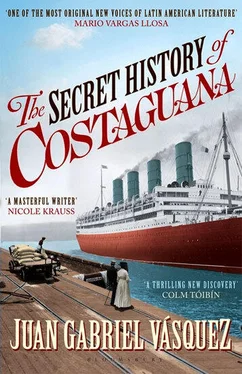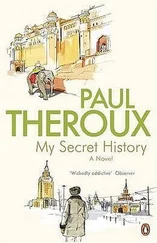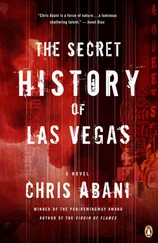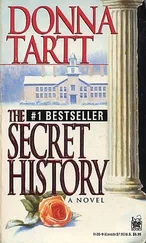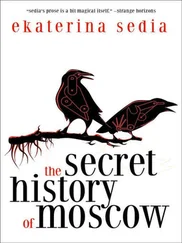And so, covering the difficult trail from Buenaventura to Tuluá on muleback — the mules walk sometimes two or three days in a row without resting, and one of them collapses on the way up the Cordillera — the contraband arrives, under General De la Pava’s supervision, at the front at Los Chancos. It is August 30, and it is almost midnight; General Joaquin María Córdoba, who will command the battle against the monster of Liberal atheism, sleeps peacefully in his tent but wakes when he hears the sound of mules and carts. He congratulates De la Pava; he makes his generals kneel and pray for the Déléstang family, pronouncing the surname variously as Delestón, Colestén, and Del Hostal. In a matter of minutes the four thousand and forty-seven Conservative soldiers are reciting the Sacred Heart of Jesus in which they trust and requesting eternal health for the crusaders of Marseille, their distant benefactors. The following morning, after years of inactivity on the noble stages of war, the Chassepot is placed in the hands of Ruperto Abello (1849), brother-in-law of the Buga parish priest, and goes back into combat.
At 6:47 a.m., its shot pierces the throat of Wenceslao Serrano, an artisan from Ibagué. At 8:13, it hits the right quadriceps of Silvestre E. Vargas, fisherman from La Dorada, making him fall; and at 8:15, after a failed reloading attempt, its bayonet is plunged into the thorax of the same Vargas, between the second and third ribs. It is 9:30 when its shot perforates the right lung of Miguel Carvajal Cotes, chicha producer; it is 9:54 when it blows apart the neck of Mateo Luis Noguera, a young journalist from Popayán who would have written great novels had he lived longer. The Chassepot kills Agustin Iturralde at 10:12, Ramón Mosquera at 10:29, Jesús María Santander at 10:56. And at 12:44, Vicente Noguera, older brother of Mateo Luis and first reader of his first poems—“Elegy for My Donkey” and “Immortal Jubilation”—who has followed Ruperto Abello for three hours across the battlefield, disobeying the orders of General Julián Trujillo and exposing himself to a court-martial that will later absolve him, takes cover behind Barrabás, his own dead horse, and fires. He does not do so with the Spenser rifle that had been issued to him before the battle but with the 20-caliber Remington that his father used to take when he went hunting in the Cauca River Valley. The bullet hits Ruperto Abello’s left ear, destroys the cartilage, breaks the cheekbone, and exits through the eye (green and celebrated in his family). Abello dies instantly; the Chassepot remains in the grass, among cow pies from a dairy herd.
Like Abello, two thousand one hundred and seven Conservative soldiers, many of them bearers of contraband Chassepots, die in Los Chancos. On the other side, one thousand three hundred and five Liberal soldiers die by the smuggled bullets of those rifles. Scouring the battlefield as part of the victorious army, young Fidel Emiliano Salgar, General Trujillo’s ex-slave, picks up the Chassepot and takes it with him as the Liberals advance toward the State of Antioquia. The Battle of Los Chancos, one of the bloodiest in the 1876 civil war, has left a profound mark on Salgar’s soul, as well as a profound hole in his left hand (produced by the rusty bayonet of Marceliano Jiménez, farm laborer). If Fidel Emiliano Salgar were a poet and French, he would undoubtedly have embarked on a sonnet called “L’ennui de la guerre.” But Salgar was neither French nor a poet, and he has no way of sublimating the unbearable tension of the last few days or the persistent image of every one of the dead men he has seen. Armed with the Chassepot, Salgar begins to talk to himself; and that night, after using the same bayonet that killed Silvestre E. Vargas to kill the sentinel (Estanislao Acosta González, 1859), Salgar reveals — by the look in his eye, by his gestures — that he has gone mad.
The Chassepot’s life ends shortly thereafter.
Correctly aimed, the rifle allows Salgar to terrorize several of his battalion comrades and enjoy doing so (it’s like a small revenge). Many of them let him be, in spite of the danger an unstable and armed man represented to a military contingent, because the magnitude of his madness was not visible from outside. By the night of September 25, the battalion, Salgar, and the rifle have crossed the State of Antioquia and arrived at the banks of the Atrato River, as part of their reconquest of Conservative territory. Night catches them at the Hacienda Miraflores. Salgar, barefoot and shirtless, points the gun at General Anzoátegui, who had been sleeping in his tent, and they walk toward the river; Salgar manages to push off in a dugout he finds on the bank, all the time with the bayonet pressed against the General’s ribs and his eyes loose and turbulent like those of a broken doll. But the dugout has gone barely ten meters into the current of the Atrato when the guards arrive at the riverbank and form an authentic firing squad. In the midst of his cloudy reasoning, Salgar raises the Chassepot, aims at the General’s head, and his last shot pierces the skull before anyone has time to do anything. The rest of the soldiers, whose names no longer matter, open fire.
The bullets — of various calibers — hit Salgar in various parts of his body: they perforate both lungs, his cheek and tongue; they destroy one of his knees and reopen the almost closed wound in his left hand, burning nerves, scorching tendons, crossing through the carpel tunnel the way a boat crosses a canal. The Chassepot floats in the air for a second and falls into the rough waters of the Atrato; it sinks, and before touching bottom is swept a few meters ahead by the current. Following it, falling backward, the corpse of a man (sixty-nine kilograms in weight) who was a slave and will not now be free.
At the moment Fidel Emiliano Salgar lands on the sandy riverbed, startling a ray and receiving a sting — not that the dead body feels anything, not that his tissues retract in reaction to the venom, not that his muscles suffer fevers or his blood is contaminated — at that very moment, the apprentice sailor Korzeniowski, on board the Saint-Antoine , takes one last look at the coastline of the port of Saint-Pierre in Martinique. Several days have gone by since, having completed the rifles-to-overthrow-Liberal-governments mission, they left Colón and the territorial waters of the United States of Colombia. And, since this seems to be the chapter of things unknown, I better state what Korzeniowski doesn’t know at that moment.
He doesn’t know the names or ages of the one thousand three hundred and thirty-five victims of the Chassepots. He doesn’t even know there were one thousand three hundred and thirty-five victims of the Chassepots. He doesn’t know that the contraband will have been in vain, that the Liberal and Masonic government will win the war against the Conservative Catholics and it will take another war — or a resumption of the same one — to alter that state of things. He doesn’t know what Monsieur Déléstang will think, in Marseille, when he finds out about it, or if he’ll go on to interfere in other crusades. He doesn’t know that one of the gutter press newspapers, La Justicia , will invent many years later an absurd version of his sojourn on the Colombian coast: in it, Korzeniowski takes charge of all the negotiations and sells the weapons to a certain Lorenzo Daza, delegate of the Liberal government who later “gives them up for lost” and resells them “for double their price” to the Conservative revolutionaries. Korzeniowski, who doesn’t even know who Daza is, carries on with his gaze fixed on Martinique, and carries on not knowing things. He doesn’t know that the coastline of Saint-Pierre will not ever be the same, at least not for him, for the city known as Old Paris will be erased from the map in a quarter of a century, completely obliterated like an undesirable historical fact (but this is not the time to speak of that disaster). He doesn’t know that, in a matter of hours, when they sail between St. Thomas and Port-au-Prince, he will meet the violence of the East Wind and the West Wind, and doesn’t know that much later he’ll write about that violence. Between Port-au-Prince and Marseille he will turn nineteen, and won’t know that at home awaits the most difficult chain of events of his youth, events that will culminate, for him, with a gunshot to the heart.
Читать дальше
